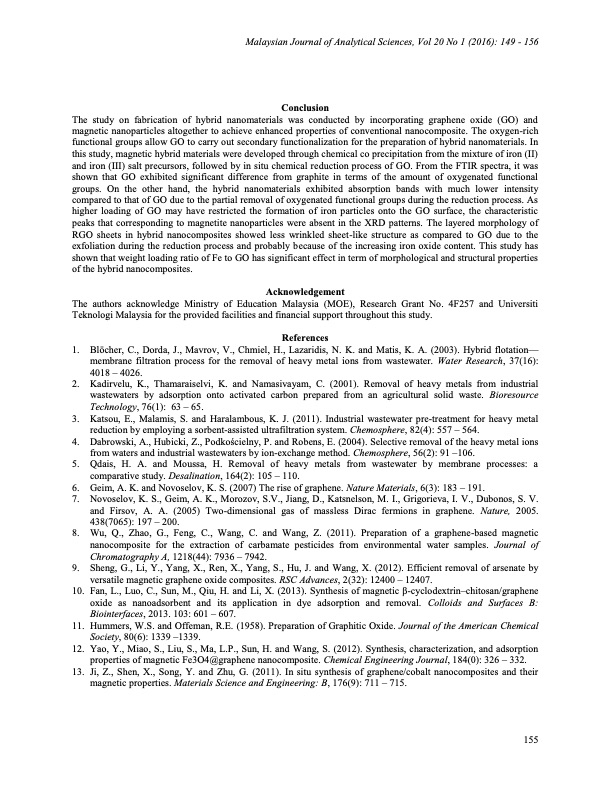
PDF Publication Title:
Text from PDF Page: 007
Malaysian Journal of Analytical Sciences, Vol 20 No 1 (2016): 149 - 156 Conclusion The study on fabrication of hybrid nanomaterials was conducted by incorporating graphene oxide (GO) and magnetic nanoparticles altogether to achieve enhanced properties of conventional nanocomposite. The oxygen-rich functional groups allow GO to carry out secondary functionalization for the preparation of hybrid nanomaterials. In this study, magnetic hybrid materials were developed through chemical co precipitation from the mixture of iron (II) and iron (III) salt precursors, followed by in situ chemical reduction process of GO. From the FTIR spectra, it was shown that GO exhibited significant difference from graphite in terms of the amount of oxygenated functional groups. On the other hand, the hybrid nanomaterials exhibited absorption bands with much lower intensity compared to that of GO due to the partial removal of oxygenated functional groups during the reduction process. As higher loading of GO may have restricted the formation of iron particles onto the GO surface, the characteristic peaks that corresponding to magnetite nanoparticles were absent in the XRD patterns. The layered morphology of RGO sheets in hybrid nanocomposites showed less wrinkled sheet-like structure as compared to GO due to the exfoliation during the reduction process and probably because of the increasing iron oxide content. This study has shown that weight loading ratio of Fe to GO has significant effect in term of morphological and structural properties of the hybrid nanocomposites. Acknowledgement The authors acknowledge Ministry of Education Malaysia (MOE), Research Grant No. 4F257 and Universiti Teknologi Malaysia for the provided facilities and financial support throughout this study. References 1. Blöcher, C., Dorda, J., Mavrov, V., Chmiel, H., Lazaridis, N. K. and Matis, K. A. (2003). Hybrid flotation— membrane filtration process for the removal of heavy metal ions from wastewater. Water Research, 37(16): 4018 – 4026. 2. Kadirvelu, K., Thamaraiselvi, K. and Namasivayam, C. (2001). Removal of heavy metals from industrial wastewaters by adsorption onto activated carbon prepared from an agricultural solid waste. Bioresource Technology, 76(1): 63 – 65. 3. Katsou, E., Malamis, S. and Haralambous, K. J. (2011). Industrial wastewater pre-treatment for heavy metal reduction by employing a sorbent-assisted ultrafiltration system. Chemosphere, 82(4): 557 – 564. 4. Dabrowski, A., Hubicki, Z., Podkościelny, P. and Robens, E. (2004). Selective removal of the heavy metal ions from waters and industrial wastewaters by ion-exchange method. Chemosphere, 56(2): 91 –106. 5. Qdais, H. A. and Moussa, H. Removal of heavy metals from wastewater by membrane processes: a comparative study. Desalination, 164(2): 105 – 110. 6. Geim, A. K. and Novoselov, K. S. (2007) The rise of graphene. Nature Materials, 6(3): 183 – 191. 7. Novoselov, K. S., Geim, A. K., Morozov, S.V., Jiang, D., Katsnelson, M. I., Grigorieva, I. V., Dubonos, S. V. and Firsov, A. A. (2005) Two-dimensional gas of massless Dirac fermions in graphene. Nature, 2005. 438(7065): 197 – 200. 8. Wu, Q., Zhao, G., Feng, C., Wang, C. and Wang, Z. (2011). Preparation of a graphene-based magnetic nanocomposite for the extraction of carbamate pesticides from environmental water samples. Journal of Chromatography A, 1218(44): 7936 – 7942. 9. Sheng, G., Li, Y., Yang, X., Ren, X., Yang, S., Hu, J. and Wang, X. (2012). Efficient removal of arsenate by versatile magnetic graphene oxide composites. RSC Advances, 2(32): 12400 – 12407. 10. Fan, L., Luo, C., Sun, M., Qiu, H. and Li, X. (2013). Synthesis of magnetic β-cyclodextrin–chitosan/graphene oxide as nanoadsorbent and its application in dye adsorption and removal. Colloids and Surfaces B: Biointerfaces, 2013. 103: 601 – 607. 11. Hummers, W.S. and Offeman, R.E. (1958). Preparation of Graphitic Oxide. Journal of the American Chemical Society, 80(6): 1339 –1339. 12. Yao, Y., Miao, S., Liu, S., Ma, L.P., Sun, H. and Wang, S. (2012). Synthesis, characterization, and adsorption properties of magnetic Fe3O4@graphene nanocomposite. Chemical Engineering Journal, 184(0): 326 – 332. 13. Ji, Z., Shen, X., Song, Y. and Zhu, G. (2011). In situ synthesis of graphene/cobalt nanocomposites and their magnetic properties. Materials Science and Engineering: B, 176(9): 711 – 715. 155PDF Image | GRAPHENE-BASED MAGNETIC HYBRID NANOCOMPOSITE

PDF Search Title:
GRAPHENE-BASED MAGNETIC HYBRID NANOCOMPOSITEOriginal File Name Searched:
JashielaWani-20-1-16.pdfDIY PDF Search: Google It | Yahoo | Bing
Salgenx Redox Flow Battery Technology: Power up your energy storage game with Salgenx Salt Water Battery. With its advanced technology, the flow battery provides reliable, scalable, and sustainable energy storage for utility-scale projects. Upgrade to a Salgenx flow battery today and take control of your energy future.
| CONTACT TEL: 608-238-6001 Email: greg@infinityturbine.com | RSS | AMP |